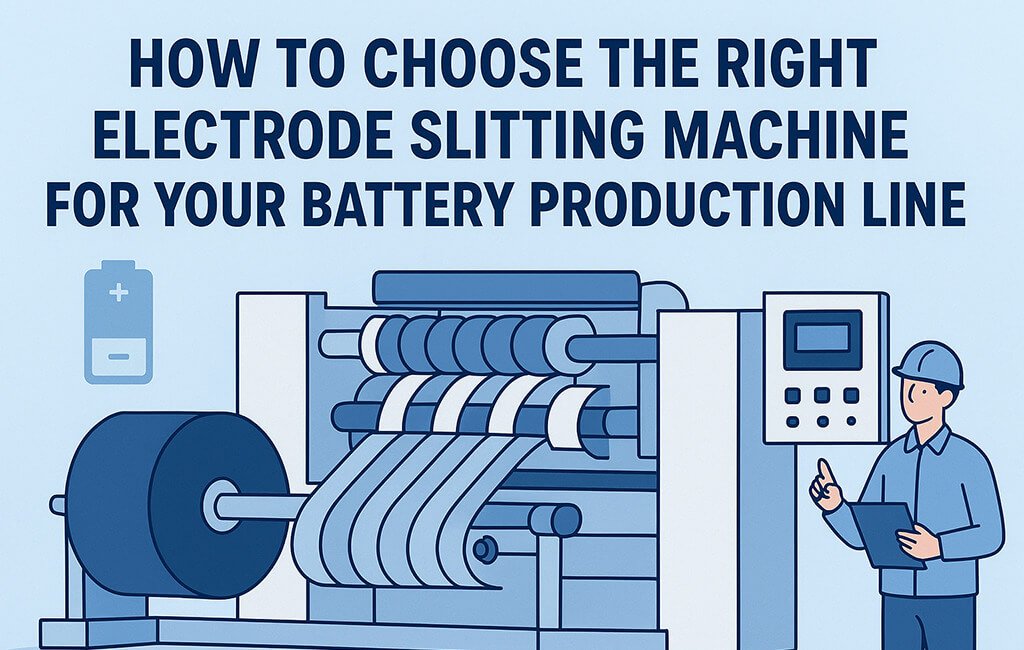Selecting an electrode slitting machine represents a critical decision in battery manufacturing. It directly impacts product quality, production efficiency, and operational costs. The right slitting system ensures precise electrode dimensions, minimal edge defects, and seamless integration with upstream coating and downstream assembly processes.
This comprehensive guide examines key selection criteria, technical specifications, and quality control requirements for electrode slitting equipment. Whether producing cylindrical cells, pouch cells, or emerging formats like 4680 tabless designs, understanding slitting machine capabilities ensures optimal battery performance and manufacturing yield.
What Are the Essential Technical Specifications for Electrode Slitting Machines?
Technical specifications determine slitting precision, production capacity, and material compatibility. Core parameters include cutting accuracy, web tension control, maximum slitting width, and line speed capabilities.
Modern electrode slitting machines incorporate advanced features like photoelectric tracking correction, magnetic powder clutch tension systems, and inline inspection capabilities. These technologies ensure consistent edge quality across various electrode materials and coating thicknesses.
| Specification | Standard Range | High-Precision Range | Application Notes |
|---|---|---|---|
| Cutting Width Tolerance | ±0.5 mm | ±0.1 mm | Tighter tolerances for high-energy density cells |
| Web Tension Control | 5-50 N | 2-100 N | Lower tension for thin separators, higher for thick cathodes |
| Maximum Web Width | 300-500 mm | 600-1200 mm | Larger widths for EV battery production |
| Line Speed | 10-30 m/min | 40-80 m/min | Speed varies with material thickness and coating type |
| Edge Alignment Accuracy | ±0.3 mm | ±0.05 mm | Critical for tabless electrode designs |
| Rewinding Tension Variance | ±5% | ±2% | Prevents telescoping in finished rolls |
How Do Different Blade Materials Affect Electrode Slitting Quality?
Blade material selection directly impacts cut quality, service life, and maintenance requirements. The choice depends on electrode material properties, coating hardness, and production volume requirements.
Tungsten carbide blades offer exceptional wear resistance for high-volume production. Ceramic blades provide superior edge quality for sensitive materials. Tool steel blades balance cost and performance for pilot-scale operations.
Blade Material Compatibility Matrix
Aluminum current collectors typically require harder blade materials due to their tendency to cause rapid wear. Copper foils, being softer, allow broader blade material options but demand sharper cutting angles to prevent burr formation.
Coated electrodes introduce additional complexity, as the active material layer affects cutting dynamics. Silicon-containing anodes require specialized blade geometries to manage the material’s brittleness. High-nickel cathodes benefit from coated blade surfaces to reduce material adhesion.
What Precision Tolerances Are Required for Different Battery Formats?
Battery format significantly influences required slitting precision. Cylindrical cells demand the tightest width tolerances due to precise winding requirements. Pouch cells allow slightly relaxed specifications but require superior edge quality to prevent separator puncture.
Emerging formats like 4680 tabless cells introduce unique challenges. They require exceptional alignment accuracy and consistent edge quality across the entire electrode width. These applications often specify tolerances within ±0.05 mm to ensure proper current collection.
Format-Specific Requirements
Consumer electronics batteries typically operate with standard precision requirements. Their smaller size provides some tolerance for dimensional variations. Energy storage systems, with their larger cell formats, paradoxically require tighter controls to manage thermal expansion effects.
Electric vehicle applications represent the most demanding specifications. They combine high production volumes with stringent quality requirements. These applications often require inline measurement systems capable of detecting sub-millimeter variations in real-time.
How to Prevent Burr Formation During Electrode Slitting?
Burr prevention requires optimization of multiple parameters including blade sharpness, cutting angle, web tension, and support roller configuration. Even minimal burrs can cause internal short circuits, making this a critical quality parameter.
Key prevention strategies include maintaining optimal blade-to-anvil pressure and implementing regular blade inspection schedules. Controlling web tension throughout the slitting zone is essential. Temperature management also plays a role, as thermal expansion can affect cutting precision.
Burr Detection and Measurement
Modern slitting lines incorporate laser scanning or vision systems to detect burr formation in real-time. These systems typically measure burr height and frequency. They trigger alerts when specifications exceed acceptable limits.
Post-slitting inspection should include both visual examination and electrical testing. Copper electrodes require particular attention. Their ductility makes them prone to burr formation under suboptimal conditions.
Integration Requirements for Coating-to-Slitting Process Flow
Successful integration between coating and slitting operations requires careful consideration of web handling, tension control, and environmental conditions. Coated electrodes must maintain dimensional stability throughout the transfer process.
Key integration points include web accumulator systems to decouple coating and slitting speeds. Tension control zones prevent coating damage. Environmental controls manage moisture absorption. Proper integration minimizes waste and ensures consistent product quality.
Web Tension Management Across Process Zones
Tension requirements vary significantly between coating exit and slitting entry. Freshly coated electrodes require gentle handling to prevent coating delamination. The slitting zone demands higher tension for cutting accuracy.
Transition zones typically employ dancer roller systems or load cells to monitor and adjust tension continuously. Advanced systems incorporate predictive algorithms. These anticipate tension variations based on material properties and operating conditions.
What Dust Extraction Systems Are Essential for Electrode Slitting?
Dust generation during slitting poses both quality and safety risks. Effective extraction systems remove particles at the cutting point. They maintain proper airflow to prevent contamination of adjacent electrode surfaces.
System design must consider particle size distribution, material properties, and production environment requirements. HEPA filtration typically addresses submicron particles. Cyclonic separators handle larger debris.
Extraction System Specifications
Airflow velocity at the cutting zone should range from 15-25 m/s. This is sufficient to capture particles without disturbing web stability. Multiple extraction points along the slitting width ensure comprehensive particle removal.
Filter maintenance schedules depend on material type and production volume. Graphite anodes generate more dust than lithium metal oxide cathodes. They require more frequent filter replacement and higher extraction capacities.
Quality Control Checkpoints for Slitting Operations
Comprehensive quality control encompasses dimensional verification, edge quality assessment, and surface inspection. Establishing checkpoints at critical stages prevents defective material from reaching downstream processes.
Essential measurements include width tolerance verification, edge straightness evaluation, and burr height quantification. Advanced systems incorporate inline CCD cameras for continuous monitoring of these parameters.
Troubleshooting Checklist for Common Slitting Issues
- Telescoping rolls: Check rewinding tension uniformity, verify core alignment, inspect for uneven web thickness
- Edge dust accumulation: Verify extraction system operation, check blade sharpness, examine cutting angle settings
- Width variation: Calibrate photoelectric tracking, inspect blade mounting stability, verify web tension consistency
- Wavy edges: Adjust blade penetration depth, check anvil roller condition, optimize cutting speed
- Coating delamination: Reduce web tension in transition zones, verify roller surface condition, check for excessive vibration
- Uneven slit spacing: Inspect blade holder alignment, verify spacer accuracy, check for thermal expansion effects
How to Calculate Required Production Capacity?
Capacity planning must account for actual cutting time, setup changes, maintenance intervals, and quality inspection requirements. Effective capacity typically reaches 70-85% of theoretical maximum due to these factors.
Key variables include the number of slits per setup, average roll length, changeover frequency, and downstream process constraints. Integration with coating line speed often represents the primary bottleneck in continuous operations.
Capacity Calculation Framework
Begin with annual production targets and work backward to determine required hourly throughput. Factor in planned maintenance (typically 5-10% of operating time). Include unplanned downtime allowances (2-5% for well-maintained equipment).
Multi-width slitting capabilities enhance flexibility but may reduce overall capacity due to increased setup times. Single-width dedicated lines achieve higher utilization rates. However, they limit product mix flexibility.
Automation Levels and Their Impact on Quality
Automation options range from basic semi-automatic systems with manual loading to fully integrated lines with robotic handling. Higher automation levels typically improve consistency while reducing labor costs. They also enable automatic quality feedback loops.
Key automation features include automatic blade positioning, web threading systems, and tension control feedback loops. Advanced systems incorporate integrated data collection. Machine learning algorithms enable predictive maintenance and quality optimization.
Semi-Automatic vs. Fully Automatic Systems
Semi-automatic systems suit pilot production and frequent product changes. They offer flexibility at lower capital investment. Operators manually load rolls and adjust parameters, providing hands-on process control.
Fully automatic systems excel in high-volume production with standardized products. Automatic splice detection, blade wear monitoring, and closed-loop quality control minimize operator intervention. These features maximize consistency in production environments.
Maintenance Requirements and Blade Replacement Schedules
Preventive maintenance programs significantly impact slitting quality and equipment availability. Blade replacement represents the most frequent maintenance task. Intervals are determined by material type and production volume.
Typical blade life ranges from 500,000 to 2,000,000 linear meters. This depends on material abrasiveness and cutting parameters. Establishing blade wear curves for specific applications optimizes replacement timing.
Critical Maintenance Points
Beyond blade replacement, regular maintenance encompasses bearing lubrication, belt tension adjustment, and alignment verification. Photoelectric sensors require periodic cleaning to maintain tracking accuracy.
Anvil roller condition critically affects cut quality. Surface hardness degradation or damage creates inconsistent cutting pressure. This leads to quality variations. Scheduled roller refurbishment prevents gradual quality deterioration.
Safety Features and Compliance Standards
Modern slitting equipment incorporates multiple safety features to protect operators and maintain regulatory compliance. CE certification represents the baseline for European markets. Additional standards may apply regionally.
Essential safety features include emergency stop systems, safety light curtains, and two-hand control stations. Blade guard mechanisms provide additional protection. Lockout/tagout procedures must address both mechanical and electrical hazards during maintenance.
Operator Safety Protocols
Comprehensive safety protocols encompass equipment-specific training and personal protective equipment requirements. Standard operating procedures ensure consistent safety practices. Regular safety audits ensure continued compliance and identify improvement opportunities.
Dust exposure limits require particular attention in battery manufacturing environments. Material safety data sheets guide appropriate respiratory protection. They also specify ventilation requirements for specific electrode materials.
Cost Considerations Beyond Initial Investment
Total ownership cost analysis must consider consumables, maintenance, energy consumption, and yield losses. Blade replacement typically represents the largest ongoing expense. Maintenance labor follows as the second major cost factor.
Energy consumption varies significantly with automation level and production speed. High-precision systems may consume 20-50 kW during operation. This contributes substantially to operating costs in high-volume facilities.
Yield Impact Analysis
Slitting quality directly affects downstream yield through width variations, edge defects, and contamination. A 1% improvement in slitting yield can justify significant equipment investment. This is particularly true in high-volume production environments.
Quality-related costs include scrap material, rework time, and potential warranty claims from field failures. Investing in precision equipment and robust quality control systems typically provides positive return. This occurs through reduced quality costs and improved customer satisfaction.
Glossary
Web Tension: The pulling force applied to electrode material during slitting, measured in Newtons, critical for maintaining dimensional accuracy and preventing material damage.
Photoelectric Tracking: Optical sensor system that detects electrode edge position and automatically adjusts slitting alignment to maintain consistent edge margins.
Magnetic Powder Clutch: Tension control device using magnetic particles to provide smooth, adjustable resistance for precise web tension management.
Burr Height: Measurement of raised material at cut edges, typically specified in micrometers, critical for preventing internal short circuits in assembled cells.
Telescoping: Lateral shifting of wound electrode layers creating an uneven roll end, caused by tension variations or alignment issues during rewinding.
Anvil Roller: Hardened steel cylinder against which slitting blades cut, requiring precise surface finish and hardness for consistent cutting quality.
CCD Inspection: Charge-coupled device camera system for real-time visual inspection of electrode edges, width, and surface defects during slitting.
Dancer Roller: Movable roller system that maintains constant web tension by automatically adjusting position based on material tension variations.
Conclusion
Selecting the right electrode slitting machine requires careful evaluation of technical specifications, material compatibility, and quality requirements. Production integration needs must also be considered. The optimal choice balances precision capabilities with production flexibility while ensuring consistent product quality.
Success in electrode slitting extends beyond equipment selection to encompass proper integration, maintenance practices, and quality control systems. By addressing these comprehensive requirements, manufacturers can achieve the precision and efficiency demanded by modern battery production. They maintain the flexibility to adapt to evolving cell designs and chemistries.



